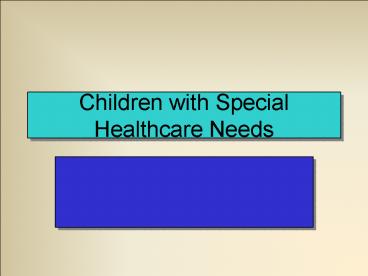Children with Special Healthcare Needs - PowerPoint PPT Presentation
1 / 17
Title:
Children with Special Healthcare Needs
Description:
Technology-assisted Children = Those with special health care needs who depend ... Trisomy 21 (Down's syndrome) 1 in 800 births. more common in older mothers ... – PowerPoint PPT presentation
Number of Views:64
Avg rating:3.0/5.0
Title: Children with Special Healthcare Needs
1
Children with Special Healthcare Needs
2
Children with Special Health Care Needs
- Children with disabilities including
- Physical limitations
- Mental limitations
- Chronic illness
3
Children with Special Health Care Needs
- Technology-assisted Children Those
with special health care needs who depend on
medical devices to support vital bodily functions.
4
Children with Special Health Care Needs
- Assessment
- Critical to ask parent or home care attendant
about patients - baseline
- present problem (why did they call?)
- past history
- past treatment for similar problem
- hospital where the patient is normally seen
5
Children with Special Health Care Needs
- Tracheostomy
- bypass upper airway obstruction caused by birth
defect, surgery, trauma - allow long-term mechanical ventilatory support as
result of chronic disease - temporary following severe illness, trauma
- mucus obstruction is common problem
- instill sterile saline, then suction while
withdrawing catheter
6
Children with Special Health Care Needs
7
Children with Special Health Care Needs
8
Children with Special Health Care Needs
- Constant Positive Airway Pressure
- Recurring partial airway obstruction
- Weak inspiratory effort
- Some only wear device at night
- May be disconnected but child may tire easily
9
Children with Special Health Care Needs
- Central Venous Catheters
- May be used to deliver
- nutrition
- special medications
- Usually on chest but may be at neck, groin or arm
10
Children with Special Health Care Needs
- CSF shunt
- Used to drain fluid from cranial cavity into
abdomen - Obstruction may result in ? ICP or seizures
11
Children with Special Health Care Needs
- Feeding Catheters
- Deliver nutrition or medication
- NG/OG tube used for brief periods or surgically
implanted for longer periods - gastrostomy tube (GT) passes through abdomen into
stomach - jejunostomy tube (JT) passes through abdomen into
small intestine - percutaneous endoscopic gastrostomy (PEG)
(button) similar to GT but is equipped with a
cap and valve
12
Children with Special Health Care Needs
13
Children with Special Health Care Needs
- Pacemaker
- Demand, constant, or antiarrhythmic
- Generator can usually be felt under skin
- Leads may fracture causing failure
- Ask about type of pacemaker and its function
14
Children with Special Health Care Needs
- Congenital Heart Disease
- Usually manifested in first few days of life
- Often detected prenatally
- Examples
- Patent ductus arteriosus
- Atrial septal defect
- Ventricular septal defect
- Tetralogy of Fallot
- Transposition of great vessels
- Aortic coarctation
15
Children with Special Health Care Needs
- Congenital malformation
- Trisomy 21 (Downs syndrome)
- 1 in 800 births
- more common in older mothers
- smaller stature developmental delays small
midface with upturned nose flat occiput, short
broad hands and feet short ears exaggerated
space between first and second toes
16
Children with Special Health Care Needs
- Congenital Malformation
- Trisomy 18
- 1 in 8,000 births
- higher risk of spontaneous death in utero
- small, premature appearance narrow nose
prominent occiput cleft lip or palate
congenital heart disease overlapping of finders
(index over 3rd, 5th over 4th) developmental
delays underdeveloped nails - most die in infancy few survive 1 year
17
Children with Special Health Care Needs
- Congenital Malformation
- Trisomy 13
- 1 in 10,000 births
- higher risk of spontaneous death in utero
- scalp defects cleft lip or palate microcephaly
sloping forehead congenital heart disease
overlapping of fingers and toes underdeveloped
nails developmental delays - most die in infancy few survive 1 year































